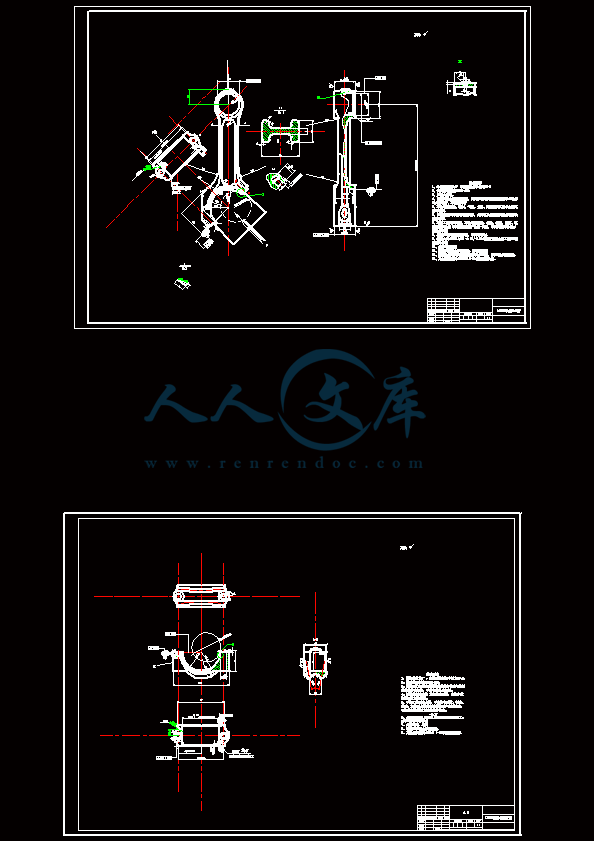L4100柴油机曲柄连杆机构设计(全套含CAD图纸)
收藏
资源目录

压缩包内文档预览:(预览前20页/共69页)
编号:10112816
类型:共享资源
大小:2.27MB
格式:ZIP
上传时间:2018-05-20
上传人:机****料
认证信息
个人认证
高**(实名认证)
河南
IP属地:河南
50
积分
- 关 键 词:
-
l4100
柴油机
曲柄
连杆机构
设计
全套
cad
图纸
- 资源描述:
-









- 内容简介:
-
下载后包含有 CAD 图纸和说明书,咨询 Q 197216396 或 119709851L4100 柴油机设计(曲柄连杆机构)摘 要本次设计主要针对性设计了 L4100 柴油机的曲柄连杆机构,对这个系统中的各种零部件进行分析相应的分析和设计。由于发动机作为一台完整的动力机械的心脏部位,扮演着居足轻重的加角色。首先从整体方面着手,先确定整个机体采用的形式,确定整机的外形尺寸。再着眼于各个细节部分。将设计任务逐级分配下去,从缸盖的结构,气门传动组的设计,再到活塞连杆组的连杆、活塞、以及曲轴的设计,最后是相关传动机构的设置,油底壳的外形尺寸等等一系列的复杂设计,最后组成一台完整的发动机。若中间任何一道工序出现差错,这一项任务的完成就会大打折扣。因此本此设计在着手设计曲柄连杆机构的所有零部件时,都本着精益求精的态度去完成。由于已经给定了发动机的相关参数,所以在设计之初就需要对曲柄连杆连杆机构中的每一个构件(包括活塞,连杆,曲轴)我们都采用先分析其相应的运动情况,再以此为依据设计相关参数,保证动力学分析时能够合理有效的进行,最后进行同时相关强度、硬度的校核。根据最终校核的情况再做出相应的调整。在保证最大化的轻巧,灵便的同时,保证相关技术要求。最后用 CAD 绘出相应的几何图形。关键词:柴油机,曲柄连杆机构,动力学分析,CAD 制图下载后包含有 CAD 图纸和说明书,咨询 Q 197216396 或 119709852L4100 Diesel Engine Design (Connecting Rod Mechanism)ABSTRACTThe main purpose of this design is to design the crank connecting rod mechanism of the L4100 diesel engine .including a variety of components . As the heart of the mechanical parts, 下载后包含有 CAD 图纸和说明书,咨询 Q 197216396 或 119709853this system plays a pivotal role.First from the overall aspects of the first to determine the form of the whole body to determine the overall size of the machine. And then focus on the details of the part. The design task is assigned step by step, from the structure of the cylinder head, the design of the valve drive group, to the design of the connecting rod of the piston connecting rod, the piston, and the crankshaft. Finally, the setting of the relevant transmission mechanism, Size and so on a series of complex design, and finally form a complete engine. If any of the middle of a process error, the completion of this task will be greatly reduced. So this design in the design of the crank link mechanism of all parts, are in the attitude of excellence to complete.As the engine has been given the relevant parameters, so the beginning of the design of the crank connecting rod mechanism in each of the components (including the piston, connecting rod, crankshaft) we have to use the first analysis of the corresponding movement, and then As the basis for the design of relevant parameters to ensure that the dynamic analysis can be reasonable and effective, and finally the relevant strength, hardness of the check. According to the final check the situation and then make the appropriate adjustments. In ensuring the maximum lightweight, flexible at the same time, to ensure that the relevant technical requirements. Finally, the use of three-dimensional software CAD to produce the corresponding geometric model.KEY WORDS: diesel engine,the crank connecting rod mechanism;dynamic analysis,three-dimensional software CAD目 录下载后包含有 CAD 图纸和说明书,咨询 Q 197216396 或 119709854前言.1第一章 曲柄连杆机构受力分析 .2 1.1 曲柄连杆机构运动学 .2 1.1.1 活塞的位移 .2 1.1.2 活塞的速度 .4 1.1.3 活塞的加速度 .4 1.2 曲柄连杆机构中的作用力 .4 1.2.1 气缸内可燃混合气的作用力 .5 1.2.2 机构的惯性力 .5第二章 活塞组的设计 .14 2.1 活塞的工作环境总括 .14 2.1.1 活塞的工作条件和设计要求 .14 2.1.2 工作条件 .14 2.1.3 活塞头部的设计 .15 2.1.4 活塞裙部的设计 .17下载后包含有 CAD 图纸和说明书,咨询 Q 197216396 或 119709855 2.2 活塞环设计及计算 .19 2.2.1 活塞环形状及主要尺寸设计 .19 2.2.2 活塞环强度校核 .192.3 本章小结 .21第三章 连杆组的设计 .22 3.1 连杆的设计 .22 3.1.1 连杆的工作情况、设计要求和材料选用 .22 3.1.2 连杆长度的确定 .23 3.1.3 连杆小头的结构设计与强度、刚度计算 .23 3.1.4 连杆杆身的结构设计与强度计算 .26 3.1.5 连杆大头的结构设计与强度、刚度计算 .29 3.2 连杆螺栓的设计 .31 3.2.1 连杆螺栓的工作负荷与预紧力 .31 3.2.2 连杆螺栓的屈服强度校核和疲劳计算 .31 3.3 本章小结 .32下载后包含有 CAD 图纸和说明书,咨询 Q 197216396 或 119709856第四章 曲轴的设计 .33 4.1 曲轴的结构型式和材料的选择 .33 4.1.1 曲轴的结构型式 .33 4.1.2 曲轴的材料 .33 4.2 曲轴的主要尺寸的确定和结构细节设计 .34 4.2.1 曲柄销的直径和长度 .34 4.2.2 主轴颈的直径 和长度 .341D1L 4.2.3 曲柄 .34 4.2.4 平衡重 .35 4.2.5 油孔的位置和尺寸 .35 4.3 曲轴的疲劳强度校核 .36 4.3.1 作用于单元曲拐上的力和力矩 .36 4.3.2 名义应力的计算 .41 4.4 本章小结 .43结 论 .44下载后包含有 CAD 图纸和说明书,咨询 Q 197216396 或 119709857参考文献.43致 谢 .46下载后包含有 CAD 图纸和说明书,咨询 Q 197216396 或 119709858下载后包含有 CAD 图纸和说明书,咨询 Q 197216396 或 119709859前 言1.选题的意义和目的截止到如今,柴油机已经走过了风风雨雨的 80 多年的岁月历程。这一段岁月中,柴油机的发展有过繁荣,也有过令人唏嘘的阶段。但是随着我们一代又一代人的努力,和坚持不懈的奋斗,柴油机已经取得了可喜的成就,被广泛应用在国民生产生活的各个领域。众所周知,一台发动机能够正常的运行,一定离不开曲柄连杆机构这样一个能够进行动力传动系统。此系统保证发动机各个工作循环的顺利进行,同时将活塞顶部可燃混合气然烧产生的气体压力转化为曲轴的转矩对外输出。其中活塞和缸盖在发动机工作中提供然烧反应场所,连杆在整个运动过程中主要承受着来自高温气体的压力和活塞的王付惯性力所残生的狡辩载荷。初次之外,连杆在在狡辩载荷的作用下还会发生断裂,将会导致一系列的事故的发省。严重者导致柴油机的就此报废,影响工作的正常进行,所以,保证曲柄连杆机构相关参数的正确性具有重要意义。2.主要设计内容设计一款 DS=100125mm,12h 功率 44kW/2200r/min。设计要求:1、整机装配图(纵剖) ;活塞、连杆、曲轴零件图。(总图量不少于三张 A0 图,其中手工绘图不少于一张 A0 图。 )2、撰写设计说明书,不少于 12000 字。下载后包含有 CAD 图纸和说明书,咨询 Q 197216396 或 11970985103、翻译外文资料,不少于 10000 字符。通过查阅相关资料,了解曲柄连杆机构,主要组成结构。研究各零部件的工作环境以及各种先关受力的情况。画出相应的受力分析或者剪力弯矩图,分析完成以后,决定所选尺寸是否符合相关要求,能否是整个机构配合起来能够正常运转,这对于整机的运转稳定性有着重要的意义。本次设计的内容就是要完成 L4100 柴油机的曲柄连杆机构的活塞、连杆、曲轴的设计使之能够达到我们生产所需。请对照参考观察同类发动机实物,进行曲柄连杆机构相关零件设计。车辆与交通工程学院毕业论文1中文译文火花点火发动机的燃烧火花点火发动机的燃烧过程可以大致分为三个阶段:(1)点火和火焰发展阶段,(2)火焰传播阶段, (3)火焰终止阶段。通常认为火焰发展阶段消耗了最初的 5%的燃料空气混合器(某些情况消耗 10%) 。在火焰发展阶段,点火发生,燃烧过程开始。但是却只有很少的压力升高和有用功产生。几乎发动机一个工作循环所产生的有用功都是燃烧过程的火焰传播时期产生的。火焰传播时期就是大部分空气和燃料混合气燃烧的过程(80%-90%,取决于怎样定义) 。在这段时期,缸内压力大幅增加,在活塞膨胀行程中提供压力从而产生有用功。最后剩下的 5%(某些情况下 10%)空气燃料混合气的燃烧就被定义为火焰终止期。在这段时间,缸内压力迅速下降,燃烧停止。在火花点火发动机中,燃烧过程包括一个亚音速火焰传播放热过程,这个过程是通过活塞内形成的局部均质预混合好的空气燃料混合气来实现的。由于缸内气体的湍流,涡流,挤流,火焰传播速度被大大的增加。燃料的正确燃烧以及合适的运转特性参数可以使爆震得以避免,或者几乎能够被避免。点火和火焰发展燃烧由火花塞内的电极跳火而产生,发生在上止点以前 10到 30,具体要根据燃烧室的几何形状和发动机的运行状况而定。高温的带电粒子立即点燃两电极附近的空气燃料混合气,燃烧反应由此对外进行传播。因为冷的火花塞和混合气 ,燃烧过程刚开始时速度很慢。典型火花塞电极间能量消散的相对时间如图 7-2 所示。使用的电压通常为 25000-40000福特,通过的最大电流为 200 安,持续时间为 10 纳秒。因此产生了一个温度为 60000k 的最高温度点。几乎所有的火花塞都会有一个时常为 0.001 秒,平均温度为 6000k 的放电过程。通常需要化学计量为 0.2mJ 的碳氢燃料的能量来点火并且维持自身的的可持续燃烧,会消耗多达 0.3mg 的可燃混合气。火花塞跳火放出 30 至 50mJ 的能量,然而大部分却通过传热散失掉了。车辆与交通工程学院毕业论文2能够产生使火花塞电极间跳火的高电压有好几种方式,最为常见的就是电池-线圈组合。大部分的汽车都是使用的是 12 伏 的供电系统,包括 12 伏的电源。低电压经过线圈的多次放大成为了供给火花塞条获得高电压。有些系统利用电容器使火花塞电极在适当的时间产生放电现象。大部分的小型或者中型发动机用一个发电机来驱动发动机的曲轴产生所需要的火花塞跳火电压。一些发动对每一个火花塞都有一个单独的高压发电系统,然而其他的系统只有一个配电器,一缸分配完以后就转向另外一缸。现代火花塞两电极间的距离大约为 0.7-1.7mm。如果混合气过浓或者压力过高那么稍微小一点距离也是可以接受的。 (例如:通过涡轮增压以后高的进气压力或者高的压缩比) 。两电极间燃烧的准稳态温度为 650到 750。若高于 950则有可能发生了表面点火的现象,若温度低于 350则与可能发生后燃现象。装有磨损的活塞环的冷的发动机将会消耗更多的润滑油,因此推荐使用热的火花塞来避免污垢的产生。火花塞的温度由塞子内制造的热损失路径所控制,热的塞子比冷的塞子具有更大的热阻。现在的火花塞都是由比较好的材料制造而成,比几十年前制造的那些具有更长的使用寿命。一些高质量的火花塞安装有铂尖电极,能够持续 16000km 或者更久,究其原因是因为发动机零部件替换的困难性,以及火花塞很难被替换。现代轿车在某些极端条件下,需要发动机部分移除来改变火花塞的电压,电流,电极材料,如果火花塞要长时间使用的话就必须要有一个合适的极间距离(例如:过高的电流将会使电极破损) 。然后火花塞开始跳火,产生的电火花点燃电极附近以及电极间的可燃混合气。这将行成一个球形的火焰前端并且向外传播充满整个燃烧室。刚开始时,由于火焰体积较小,传播速度不快。因为它不能产生足够的能量来快速加热周边混合气所以传播速度才会非常缓慢。反过来说,缸内压力没有快速升高,因此也就很少产生压缩加热。只有当最初的 5%-10%的空气燃料混合气着火以后,才会造成火焰前端速度到达比较高的数值,同时压力也会快速上升。开始点火的时候火花塞附近有一个比较浓的混合气是比较好的。预制混合气越浓燃烧的速度就越快,对整个的燃烧过程来说就有了一个良好的开始。火花塞布置在 进气门附近以保证较浓的可燃混合气,特别是当启动冷机的时候。现在已经出现了一个火花塞有几个电极和两个或者两个以上的跳火点。这将会产生稳定的着火过程以及火焰的快速传播。一款处于试验阶段的系统能够在最初的放电以后能够保持一个持续的电弧。由于这个额外的电火花加速了 燃烧过程的进行,当缸内的混合气被形成涡流以后使得燃烧能够进行完全。这个系统与一百年前尝试的方法非常类似。为了得到不同的极间间距的火花塞,已经投入了大量的工作,这将会使在不同工况下点火具有可调性。至少现在有一家汽车制造商正在尝试一款发动机,这款发动机将活塞的顶部作为火花塞的一个电极。使用这套系统火花点火电极的间距将会变为 1.5-8mm,同时能够降低燃油消耗和排放。车辆与交通工程学院毕业论文3火花点火发动机的火焰传播最初的 5%-10%的空气燃料混合气燃烧的时候,燃烧过程被很好的建立起来,火焰前端快速前进充满整个燃烧室。由于不断加强的涡流,紊流,挤流运动,火焰前端的传播速度是在稳定不动的可燃混合气沿直线传播的火焰传播速度的 10 倍。除此之外,在静止的混合气中从火花塞处开始以球形向外扩张的火焰前端被剧烈的扰动,也因这些运动而被传播。随着混合气的不断燃烧,温度,伴随着压力 到达一个较高的值火焰前端后面燃烧过的气体,要比前端的气体温度要高,但是所有气体的压力却是相同的。这降低了已然气体的密度同时使他们能够充分膨胀充满整个燃烧室。图表 7-3 显示,当仅仅 30%的燃料燃烧,这些已然气体就已经充满了燃烧室 60%的容积,将剩下 70%的未燃烧的混合气压缩在 40%的气缸容积中。未燃混合气的的压缩通过压缩加热提高了自身温度。除此之外,火焰前端3000k 的温度,通过辐射传递的热量又进一步提高了压力。通过热传导和热对流传递热量相比热辐射传递的热量是很少的,原因就是发动机实际循环的时间非常短。随着火焰通过整个燃烧室,它将经历温度和压力明显增加的过程。这将造成化学反应时间缩短,和火焰前端速度增加,这正是我们所需要的结果。因为辐射传热,火焰前端后边的未燃混合气温度持续增加,在燃烧过程的终点温度达到最大值。燃烧室内已燃气体的温度并不是均匀的,靠近火花塞附近的火焰刚开始燃烧的地方温度较高。因为那个地方的混合气接收到了大量的后续燃烧反应的辐射能。较低的压力升高率也就带来了较低的热效率,和较低的爆震几率。 (例如;压力的缓慢升高也就意味着燃烧的缓慢进行,和较低的爆震风险) 。因此发动机的燃烧过程就是追求较高打热效率和发动机能够有较少热损失并且平稳运行的一个折衷方案。除了涡流,紊流,挤流的效果火焰的传播速度也取决于燃料的类型和空燃比。稀薄的混合气的火焰传播速度慢,如图表 7-4 所示。稍微浓一点的混合气就会有最快的火焰传播速度对于大部分燃料而言,这种情况发生在空燃比为 1.2 附近。残余废气和再循环的废气降低了火焰传播速度。发动机转速增加带来的涡流合挤流的强度增加,从而使得火焰传播速度也会增加。火焰终止在上止点前 15到 20,90% 95%的空气燃料混合气被燃烧掉了,火焰前端也到达了燃烧室的每一个极限角落。图表 7-3 显示,至少有 5%-10%混合气被火焰前端后面的已然气体压缩在了燃烧室的一部分体积里。这时,尽管活塞早已经远离上止点,燃烧室的容积也车辆与交通工程学院毕业论文4仅仅从余隙容积增加了 10-20%。这也就意味着最后一点空气将会在燃烧室很小的角落体积内或者贴着汽缸壁与燃料发生反应。因为紧贴这汽缸壁,最后一点剩余气体以一个逐渐减少的速率进行反应。贴近壁面,涡流和混合气的运动都被阻碍了,产生了一个停滞的边界层。大的缸体质量作为一个传热介质带走了火焰反应过程中产生的很多热量。这些机械结构都降低了反应速率,和火焰传播速度,然后火焰开始渐渐熄灭。尽管火焰终止期有少部分由活塞上方缓慢的反应产生额外工功,但仍然也是我们想要的。因为气缸内的压力升高阻碍了火焰传播缓慢变到零的速率,传递到活塞顶部的力也被减缓了变小的速率,使发动机能够平稳的运行。外 文 资 料COMBUSTIONINSIENGINESThe combustion process of SI engine can be divided into three broadregions:(1)ignition and flame development,(2)flame propagation,and (3)flametermination.Flame development is generally considered the consumption of the first5% of the air-fuel mixture (some sources use the first 10%).During the flamedevelopment period,ignition occurs and the combustion process starts,but very littlepressureriseisnoticeableandlittleornousefulworkisproduced.Justaboutallusefulwork produced in an engine cycle is the result of the flame propagation period of thecombustionprocess.Thisistheperiodwhenthebulkofthefuelandairmassisburned(i.e,80-90%,depending on how defined ).During this time,pressure in the cylinder isgreatly increased,providing the force to produce work in the expansion stroke. Thefinal 5%(some sources use 10%)of the air-fuel mass that burns is classified astermination.Duringthistime,pressurequicklydecreasedandcombustionstops.In an SI engine, combustion ideally consists of an exothermic subsonic flameprogressing through a premixed air-fuel mixture,which is locally homogeneous.Thespread of the flame front is greatly increased by induced turbulence,swirl,and squishwithin the cylinder.The right combination of fuel and operation characteristics is suchthatknockisavoidedoralmostavoided.IgnitionandFlameDevelopmentCombustion is initiated by an electrical discharge across the electrodes of aspark plug .This occurs anywhere from 10 to 30 before TDC,depending on thegeometryof thecombustionchamber andtheelectrodes ignites theair-fuel mixtureinthe immediate vicinity,and the combustion reaction reaction spreads outward fromthere.Combustion starts very slowly because of the high heat losses to the relativelycoldsparkplugandgasmixture.Energy dissipation versus time across the electrodes of a typical spark plug isshown in Fig7-2.Applied potential is generally 25000-4000 volts,with a maximumcurrent on the order of 200 amps lasting about 10nsec(1nesc= 9-10 sec).This gives apeak temperature on the order of 6000h.overall spark discharge lasts about 0.001second,with an average temperature of about 6000h.A stoichiometric mixture ofhydrocarbon fuel requires about 0.2mg of energy ignite self-sustainingcombustion.This varies to as much as 3mg for nonstoichiometric mixtures.Thedischargeofasparkplugdelivers30to50mgofenergy,mostofwhich,however,islostbyheattransfer.Severaldifferent methodsare usedtoproduce thehigh voltage potential neededto cause electrical discharge across spark plug electrodes.One common system is abattery-coil combination.Most automobiles use a 12-volt electrical system,including a12-volt battery.This low voltage is multiplied many times by coil that supplies thevery high potential delivered to the spark plug.Some systems use a capacitor todischarge acrossthespark plugelectrodes at thecrankshaft togenerate the need sparkplug voltage.Some engines have a separate high-voltage generation system for eachspark plug,while others have a single system with a distributor that shifts from onecylindertothenext.The gap distance between electrodes on a modern spark plug is about0.7to1.7mm.Smaller gaps are acceptable if there is a rich air-fuel mixture or if thepressure is high(i.e,high inlet pressure by turbocharging or a high compressionratio).Normal quasi-steady-state temperature of electrodes between firings should beabout650to700 .Atemperatureabove950Crisksthepossibilityofcausingsurfaceignition,and a temperature below 350 tendsto remote surface fouling over extendedtime. Colder engine with worn pistonrings that burn an excess of oil,hotter plugs arerecommended to avoid fouling.The temperature of a spark plug is controlled by theheat-loss path manufactured intothe plug.Hotter plugs have a greater heat conductionresistancethandocolderplugs.Modern spark are made with better materials and have a much greater lifespan those of a few decades ago.Some quality spark plugs with platinum-tippedelectrodes are made to last 160000km(100000 miles)or more .One reason this isdesirable is the difficulty of replacing plugs in some modern engines.Because of theincreased amount of engine equipment and smaller automobiles,the engine must bepartially removed to change the plugs voltage,current,electrode material,and gap sizemustbecompatibleiflong-lifeplugsare beused(e.g,toohigh current willwear sparkplug electrodes).Then a spark plug fires,the plasma discharge ignites the air-fuelmixture between and near the electrodes.This creates a spherical flame front thatpropagates outward into the combustion chamber.At first,the flame front moves veryslowlybecauseofitssmalloriginalsize.Itdoesnotgenerateenoughenergytoquicklyheat thesurroundinggases andthuspropagatesvery slowly.Thisinturn,doesnotraisethe cylinder pressure very quickly,and very little compression is experienced .Onlyafter the first 5-10% of the air-fuel mass is burned does the flame velocity reachhigher values with the corresponding fast rise in pressure-the flame propagationregion.It is desirable to have a slightly rich air-fuel mixture around the electrodes ofthe electrodes of the spark plug at ignition.A rich mixture ignites more readily,has afaster flame speed,and gives a better start to overall combustion process.Spark plugsaregenerallylocatedneartheintakevalvestoassurearichermixture,especiallywhenstartingacoldengine.Spark plugs with several electrodes and two or more simultaneous sparks arenow available.These give a more consistent ignition and quicker flamedevelopment.One modern experimental system gives a continuing arc after the initialdischarge.It is reasoned that this additional spark will speed combustion and givemore complete combustion as the air-fuel mixture is swirled through the combustionchamber.This system is quite similar to methods tried over a hundred yearsago.Development wok has been done to create a spark plug with a variableelectrode gap size.This would allow flexibility in ignition for different operatingconditions.At least one automobile manufacturer is experimenting with engines thatuse a point on the top of the piston as one of the spark electrodes.With thissystem,spark ignition can be initiated across gaps of 1.5 to 8 mm,with a reportedloweringoffuelconsumptionandemissions.FlamePropagationinSIEnginesBy thetimethefirst 5-10% of theair-fuel masshas been burned, thecombustionprocess is well established and the flame front moves very quickly through thecombustion chamber.Due to induced turbulence,swirl,and squish,flame propagationspeedisabout10timesfasterthaniftherewerealaminarflamefrontmovingthrougha stationary gas mixture.In addition,the flame front ,which would expand sphericallyfromthesparkpluginstationaryair,distortedandspreadbythesemotions.As the gas mixture burns,the temperature,and consequently the pressure,raisesto high values.Burned gases behind the flame front are hotter than the burned gasesbefore the front,with all the gases at about the same pressure.This decreased thedensity of the burned gases and expands them to occupy a greater percent of totalcombustion chamber volume.Figure7-3 shows that,when only 30% of the gas mass isburned,the burned gases already occupy almost 60% of the total volume,compressing70% of the mixture that is not yet burned into 40% of the total volume.Compressionoftheunburned raised theirtemperaturebycompressive heating .In addition,radiationheating emitted from the flame reaction zone,which is at the temperature on the orderof 3000K,further heats the gases ,unburned and burned,in the combustion chamber.Atemperature raise from the radiation then further raises the pressure.Heat transfer byconductionandconvectionisminorcomparedwiththatfromradiation,duetotheveryshort real time involved in each cycle.As the flame moves through the combustionchamber ,it travels through an environment that is progressively increasing intemperature and pressure.This causes the chemical reaction time to decrease and theflame front speed to increase,a desirable result.Because the radiation,the temperatureof the unburned gases behind the flame front continue to increase,reaching amaximum at the end of combustion process.Temperature of the burned gases is notuniform throughout the combustion chamber,but is higher near the spark plug wherecombustion started.This is because the gas the has experienced a greater amount ofradiationenergyinputfromlaterflamereaction.Ideally the air -fuel mixture should be about two thirds burned at TDC andalmost completely burned about 5TDC.Thus the maximum temperature and pressureoccur about 5and 10TDC.Combustion in a real four-stroke cycle SI engine isalmost,but not exactly,a constant volume process,as approximated by the idealair-standard Atto cycle.The closer combustion process is constant volume,the higherwill be the thermal efficiency.This can be seen in the comparison of the thermalefficiencies of the Atto,Dual,and Diesel cycles.However,in a real enginecycle,constant-volumecombustionisnotthebest waytooperate.Figure7-1showshowpressure riseofabout 240kpaperdegreeofenginerotationisdesirableforasmoothtransfer of force to the face of the position.Trueconstant-volume combustionwouldgive the pressure curve an infinite upward slope at TDC,with a corresponding roughengineoperation.A less pressure rise rate gives lower thermal efficiency and danger ofknock(i.e,a slower rise in pressure means slower combustion and the likelihood ofknock).The combustion process is thus
- 温馨提示:
1: 本站所有资源如无特殊说明,都需要本地电脑安装OFFICE2007和PDF阅读器。图纸软件为CAD,CAXA,PROE,UG,SolidWorks等.压缩文件请下载最新的WinRAR软件解压。
2: 本站的文档不包含任何第三方提供的附件图纸等,如果需要附件,请联系上传者。文件的所有权益归上传用户所有。
3.本站RAR压缩包中若带图纸,网页内容里面会有图纸预览,若没有图纸预览就没有图纸。
4. 未经权益所有人同意不得将文件中的内容挪作商业或盈利用途。
5. 人人文库网仅提供信息存储空间,仅对用户上传内容的表现方式做保护处理,对用户上传分享的文档内容本身不做任何修改或编辑,并不能对任何下载内容负责。
6. 下载文件中如有侵权或不适当内容,请与我们联系,我们立即纠正。
7. 本站不保证下载资源的准确性、安全性和完整性, 同时也不承担用户因使用这些下载资源对自己和他人造成任何形式的伤害或损失。

人人文库网所有资源均是用户自行上传分享,仅供网友学习交流,未经上传用户书面授权,请勿作他用。
 川公网安备: 51019002004831号
川公网安备: 51019002004831号